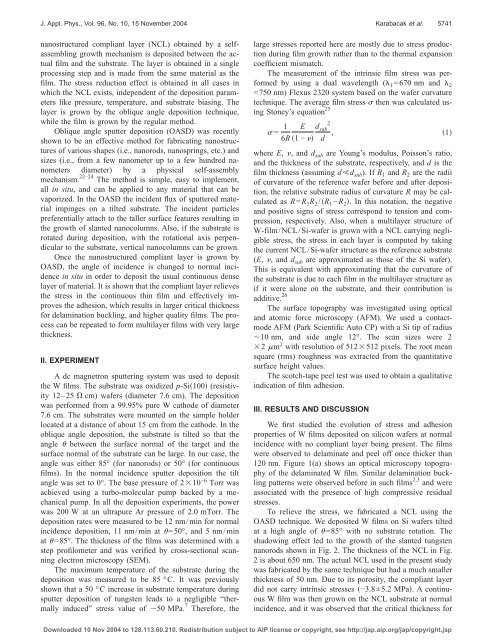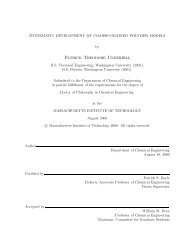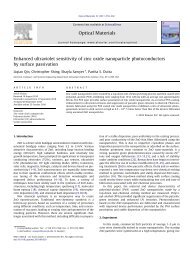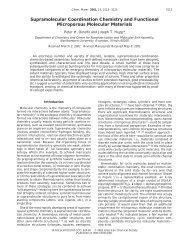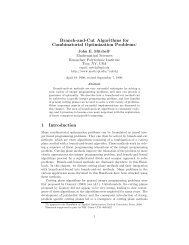Stress reduction in tungsten films using nanostructured compliant ...
Stress reduction in tungsten films using nanostructured compliant ...
Stress reduction in tungsten films using nanostructured compliant ...
Create successful ePaper yourself
Turn your PDF publications into a flip-book with our unique Google optimized e-Paper software.
J. Appl. Phys., Vol. 96, No. 10, 15 November 2004 Karabacak et al. 5741<br />
<strong>nanostructured</strong> <strong>compliant</strong> layer (NCL) obta<strong>in</strong>ed by a selfassembl<strong>in</strong>g<br />
growth mechanism is deposited between the actual<br />
film and the substrate. The layer is obta<strong>in</strong>ed <strong>in</strong> a s<strong>in</strong>gle<br />
process<strong>in</strong>g step and is made from the same material as the<br />
film. The stress <strong>reduction</strong> effect is obta<strong>in</strong>ed <strong>in</strong> all cases <strong>in</strong><br />
which the NCL exists, <strong>in</strong>dependent of the deposition parameters<br />
like pressure, temperature, and substrate bias<strong>in</strong>g. The<br />
layer is grown by the oblique angle deposition technique,<br />
while the film is grown by the regular method.<br />
Oblique angle sputter deposition (OASD) was recently<br />
shown to be an effective method for fabricat<strong>in</strong>g nanostructures<br />
of various shapes (i.e., nanorods, nanospr<strong>in</strong>gs, etc.) and<br />
sizes (i.e., from a few nanometer up to a few hundred nanometers<br />
diameter) by a physical self-assembly<br />
mechanism. 22–24 The method is simple, easy to implement,<br />
all <strong>in</strong> situ, and can be applied to any material that can be<br />
vaporized. In the OASD the <strong>in</strong>cident flux of sputtered material<br />
imp<strong>in</strong>ges on a tilted substrate. The <strong>in</strong>cident particles<br />
preferentially attach to the taller surface features result<strong>in</strong>g <strong>in</strong><br />
the growth of slanted nanocolumns. Also, if the substrate is<br />
rotated dur<strong>in</strong>g deposition, with the rotational axis perpendicular<br />
to the substrate, vertical nanocolumns can be grown.<br />
Once the <strong>nanostructured</strong> <strong>compliant</strong> layer is grown by<br />
OASD, the angle of <strong>in</strong>cidence is changed to normal <strong>in</strong>cidence<br />
<strong>in</strong> situ <strong>in</strong> order to deposit the usual cont<strong>in</strong>uous dense<br />
layer of material. It is shown that the <strong>compliant</strong> layer relieves<br />
the stress <strong>in</strong> the cont<strong>in</strong>uous th<strong>in</strong> film and effectively improves<br />
the adhesion, which results <strong>in</strong> larger critical thickness<br />
for delam<strong>in</strong>ation buckl<strong>in</strong>g, and higher quality <strong>films</strong>. The process<br />
can be repeated to form multilayer <strong>films</strong> with very large<br />
thickness.<br />
II. EXPERIMENT<br />
A dc magnetron sputter<strong>in</strong>g system was used to deposit<br />
the W <strong>films</strong>. The substrate was oxidized p-Si100 (resistivity<br />
12–25 cm) wafers (diameter 7.6 cm). The deposition<br />
was performed from a 99.95% pure W cathode of diameter<br />
7.6 cm. The substrates were mounted on the sample holder<br />
located at a distance of about 15 cm from the cathode. In the<br />
oblique angle deposition, the substrate is tilted so that the<br />
angle between the surface normal of the target and the<br />
surface normal of the substrate can be large. In our case, the<br />
angle was either 85° (for nanorods) or 50° (for cont<strong>in</strong>uous<br />
<strong>films</strong>). In the normal <strong>in</strong>cidence sputter deposition the tilt<br />
angle was set to 0°. The base pressure of 210 −6 Torr was<br />
achieved us<strong>in</strong>g a turbo-molecular pump backed by a mechanical<br />
pump. In all the deposition experiments, the power<br />
was 200 W at an ultrapure Ar pressure of 2.0 mTorr. The<br />
deposition rates were measured to be 12 nm/m<strong>in</strong> for normal<br />
<strong>in</strong>cidence deposition, 11 nm/m<strong>in</strong> at =50°, and 5 nm/m<strong>in</strong><br />
at =85°. The thickness of the <strong>films</strong> was determ<strong>in</strong>ed with a<br />
step profilometer and was verified by cross-sectional scann<strong>in</strong>g<br />
electron microscopy (SEM).<br />
The maximum temperature of the substrate dur<strong>in</strong>g the<br />
deposition was measured to be 85 °C. It was previously<br />
shown that a 50 °C <strong>in</strong>crease <strong>in</strong> substrate temperature dur<strong>in</strong>g<br />
sputter deposition of <strong>tungsten</strong> leads to a negligible “thermally<br />
<strong>in</strong>duced” stress value of 50 MPa. 7 Therefore, the<br />
large stresses reported here are mostly due to stress production<br />
dur<strong>in</strong>g film growth rather than to the thermal expansion<br />
coefficient mismatch.<br />
The measurement of the <strong>in</strong>tr<strong>in</strong>sic film stress was performed<br />
by us<strong>in</strong>g a dual wavelength ( 1=670 nm and 2<br />
=750 nm) Flexus 2320 system based on the wafer curvature<br />
technique. The average film stress then was calculated us<strong>in</strong>g<br />
Stoney’s equation 25<br />
= 1<br />
2<br />
E dsub , 1<br />
6R 1− d<br />
where E, , and dsub are Young’s modulus, Poisson’s ratio,<br />
and the thickness of the substrate, respectively, and d is the<br />
film thickness (assum<strong>in</strong>g dd sub). IfR1 and R2 are the radii<br />
of curvature of the reference wafer before and after deposition,<br />
the relative substrate radius of curvature R may be calculated<br />
as R=R 1R2/R 1−R 2. In this notation, the negative<br />
and positive signs of stress correspond to tension and compression,<br />
respectively. Also, when a multilayer structure of<br />
W-film/NCL/Si-wafer is grown with a NCL carry<strong>in</strong>g negligible<br />
stress, the stress <strong>in</strong> each layer is computed by tak<strong>in</strong>g<br />
the current NCL/Si-wafer structure as the reference substrate<br />
(E, , and dsub are approximated as those of the Si wafer).<br />
This is equivalent with approximat<strong>in</strong>g that the curvature of<br />
the substrate is due to each film <strong>in</strong> the multilayer structure as<br />
if it were alone on the substrate, and their contribution is<br />
additive. 26<br />
The surface topography was <strong>in</strong>vestigated us<strong>in</strong>g optical<br />
and atomic force microscopy (AFM). We used a contactmode<br />
AFM (Park Scientific Auto CP) with a Si tip of radius<br />
10 nm, and side angle 12°. The scan sizes were 2<br />
2 m2 with resolution of 512512 pixels. The root mean<br />
square (rms) roughness was extracted from the quantitative<br />
surface height values.<br />
The scotch-tape peel test was used to obta<strong>in</strong> a qualitative<br />
<strong>in</strong>dication of film adhesion.<br />
III. RESULTS AND DISCUSSION<br />
We first studied the evolution of stress and adhesion<br />
properties of W <strong>films</strong> deposited on silicon wafers at normal<br />
<strong>in</strong>cidence with no <strong>compliant</strong> layer be<strong>in</strong>g present. The <strong>films</strong><br />
were observed to delam<strong>in</strong>ate and peel off once thicker than<br />
120 nm. Figure 1(a) shows an optical microscopy topography<br />
of the delam<strong>in</strong>ated W film. Similar delam<strong>in</strong>ation buckl<strong>in</strong>g<br />
patterns were observed before <strong>in</strong> such <strong>films</strong> 2,3 and were<br />
associated with the presence of high compressive residual<br />
stresses.<br />
To relieve the stress, we fabricated a NCL us<strong>in</strong>g the<br />
OASD technique. We deposited W <strong>films</strong> on Si wafers tilted<br />
at a high angle of =85° with no substrate rotation. The<br />
shadow<strong>in</strong>g effect led to the growth of the slanted <strong>tungsten</strong><br />
nanorods shown <strong>in</strong> Fig. 2. The thickness of the NCL <strong>in</strong> Fig.<br />
2 is about 650 nm. The actual NCL used <strong>in</strong> the present study<br />
was fabricated by the same technique but had a much smaller<br />
thickness of 50 nm. Due to its porosity, the <strong>compliant</strong> layer<br />
did not carry <strong>in</strong>tr<strong>in</strong>sic stresses −3.8±5.2 MPa. A cont<strong>in</strong>uous<br />
W film was then grown on the NCL substrate at normal<br />
<strong>in</strong>cidence, and it was observed that the critical thickness for<br />
Downloaded 10 Nov 2004 to 128.113.60.210. Redistribution subject to AIP license or copyright, see http://jap.aip.org/jap/copyright.jsp


